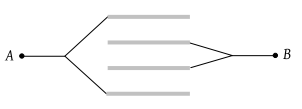A charge of 40 μC is given to a capacitor having capacitance C = 10 μF. The stored energy in ergs is
1. 80 × 10–6
2. 800
3. 80
4. 8000
A parallel plate capacitor has plate area A and separation d. It is charged to a potential difference V0. The charging battery is disconnected and the plates are pulled apart to three times the initial separation. The work required to separate the plates is
1.
2.
3.
4.
The electric field between the plates of a parallel plate capacitor when connected to a certain battery is E0. If the space between the plates of the capacitor is filled by introducing a material of dielectric constant K without disturbing the battery connections, the field between the plates shall be
1. K E0
2. E0
3.
4. None of the above
If the distance between parallel plates of a capacitor is halved and dielectric constant is doubled then the capacitance
1. Decreases two times
2. Increases two times
3. Increases four times
4. Remain the same
If there are n capacitors each of capacitance C in parallel connected to V volt source, then the energy stored is equal to
1. CV
2.
3. CV2
4.
The unit of electric permittivity is
1. Volt/m2
2. Joule/coulomb
3. Farad/m
4. Henry/m
(i) The energy stored in the capacitor when the battery is disconnected and the separation is doubled is \(E_1\)
(ii) The energy stored in the capacitor when the charging battery is kept connected and the separation between the capacitor plates is doubled is \(E_2\).
Then \(\frac{E_1}{E_2}\) value is:
1. \(4\)
2. \(\frac{3}{2}\)
3. \(2\)
4. \(\frac{1}{2}\)
Two identical capacitors are joined in parallel, charged to a potential V and then separated and then connected in series i.e. the positive plate of one is connected to negative of the other
1. The charges on the free plates are destroyed
2. The charges on the free plates are enhanced
3. The energy stored in the system increases
4. The potential difference in the free plates becomes 2V
A parallel plate capacitor is made by stacking n equally spaced plates connected alternately. If the capacitance between any two plates is C then the resultant capacitance is
1. C
2. nC
3. (n – 1)C
4. (n + 1)C
Four plates of equal area A are separated by equal distances d and are arranged as shown in the figure. The equivalent capacity is
1.
2.
3.
4.







